- AROUND THE SAILING WORLD
- BOAT OF THE YEAR
- Email Newsletters
- America’s Cup
- St. Petersburg
- Caribbean Championship
- Boating Safety


The Utiltarian Design of the S2 7.9 Remains Sought After Three-Decades Later
- By Dave Powlinson
- Updated: April 10, 2018
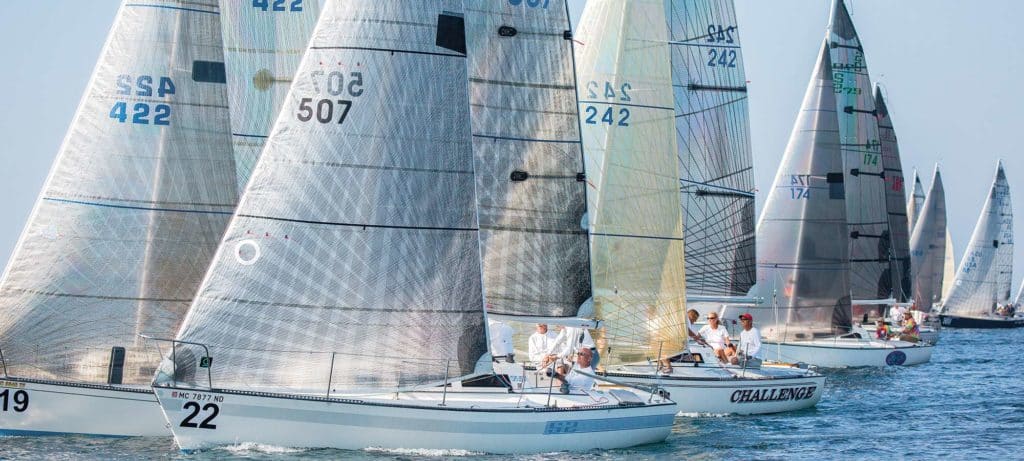
It’s late Sunday morning, and I’m aboard Chris Craig’s S2 7.9 for the National Championship. The mainsail slats as we wait for wind. A few sailors swim, and one practices backflips off his boat’s bow pulpit while the race committee dispatches its mark-set boats in multiple directions to scout for breeze elsewhere on Lake Michigan. We soon hear their reports over the VHF radio: There’s not much out there.
We’re wallowing in the middle of a large and stubborn high-pressure system. It’s hot, and hardly September weather for Holland, Michigan, but we’re optimistic. This time of the year is usually a sure bet for wind, which is part of the reason the S2 7.9 class scheduled its 2017 championship here. Plus, our host, Macatawa YC, provides a great home base and easy access to the broad lake, making it even more appealing. It’s been “that kind of summer” — one plagued with light winds. Still, everyone is taking the drifting in stride. Maybe that’s because S2 7.9 racers are a patient lot.
Or maybe because they’re just happy to be together again, assembled in this special place where the whole S2 thing started more than 30 years ago.
Eight miles down 32nd Street from Macatawa YC is the sprawling Tiara Yachts boatbuilding plant. Today they build 30- to 53-foot luxury motor yachts, but from 1980 and 1994, the building was occupied by S2 Yachts, which put out an eclectic line of sailboats that included the 7.9. Riding the 20-footer movement of the late 1970s, which was sparked by the J/24 and eventually included boats like the Merit 25 and Olson 25, the 7.9 hit a sweet spot with recreational racers. Its lifting daggerboard allows it to be ramp launched and floated in 18 inches of water, and its deck-stepped mast can be raised by two people, making it a perfectly trailerable raceboat. The 7.9s were also built to last and retain a good resale value to this day. Plus, there’s an interior that packs in a lot for a 26-footer — three berths, a galley and a head.
While other designs of the time struggled to catch on, the 7.9 was a comparative overnight success. One-design racing fleets sprang up throughout Michigan and as far south as Nashville, Tennessee, and Florida. The 7.9, dubbed a “giant killer,” also excelled in PHRF and Midget Ocean Racing Club regattas. When production ended, 545s were built.
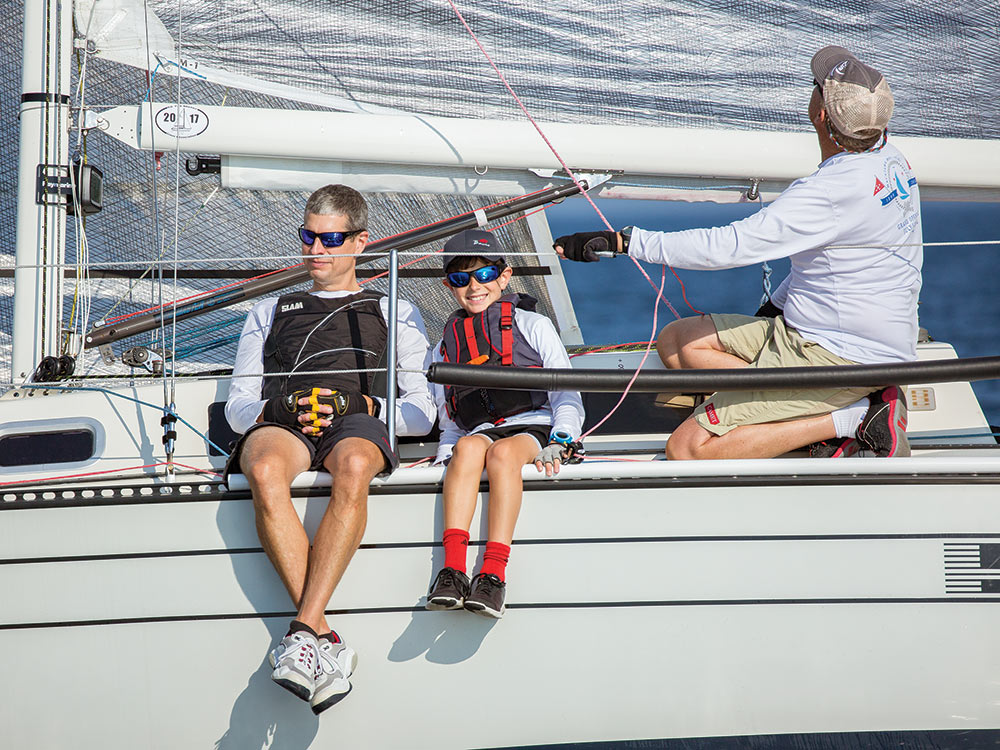
The Slikkers family founded the S2 company, hence the “S” in the name. Its sailboat line represented the company’s restart after selling its successful powerboat line to AMF. Designed by the late Scott Graham and Eric Schlageter, from Chicago, the first 7.9s were sold as the Grand Slam line, and although the name clearly represented what they hoped it would be, the boat was soon rebranded 7.9, which is the boat’s length in meters — that’s 25 feet 11 inches for imperialists.
It’s a testament to Graham and Schlageter’s utilitarian design that the boats remain sought after three decades later. “The value has stayed in the boats because they’re well-built and because of the price point,” says Tim Bosma, who has crewed aboard the 7.9 Hot Tamale since 1994.
Bosma also maintains the class’s one forum and some of its databases, so he has a good handle on what’s out there on the open market. “A while back, my skipper and I picked up one in Traverse City, Michigan, with a trailer, for around $7,000,” he confesses. “We’ll fix it up and sell it.”
The boat is a “blue-collar boat,” says Craig, who has been sailing 7.9s since he was 10.
Few people spend a lot of money on their boats, and class rules allow up to only two new sails a year. “Show up with bottom paint and race against boats with polished, clean fiberglass bottoms and still do well,” Craig says. “Boat age isn’t a delineating factor.” For example, the oldest boat at the championship is hull No. 7, owned by Drew Hilger, of Bay City, Michigan. No. 7 was built in 1981, and Hilger changed his sail number to 007 and named the boat Bond Girl , which is a reference to his wife’s employment at Gougeon Brothers Inc., manufacturers of West System epoxy.
“We’ve had it for three years,” Hilger says. “I don’t think it had seen much use, but it was also never upgraded. None of the blocks were ball-bearing, the cam cleats were not too friendly, and it had a lot of wire.”
The unspoken rule in 7.9 sailing is “the more the merrier.” To a point, of course, because the cockpit can accommodate only so many elbows.
Like many other 7.9 owners, the Hilgers bought one because they wanted a boat to race and cruise. “It just checked all the boxes. We took ours to Leeland [Michigan], sailed out to south Manitou Island, and spent three nights there,” he says. “With a 30-footer, it’s a three-day cruise to get there. We just put it on the trailer and were on the island later that day.”
This year’s championship is Hilgers’ first one-design event with the class, and they eventually learn that all S2 7.9s seem to move at about the same rate of speed, which means that once positions settle down in a race, there’s not much passing to be had, give or take a few nearby boats. And, it doesn’t seem to matter how many crew one has onboard. The unspoken rule in 7.9 sailing is “the more the merrier.” To a point, of course, because the cockpit can accommodate only so many elbows.
“Crew weight is not a big deal in this class,” says Macatawa sailor Michael Kiss, “which means you can sail with anyone you want: Bring family, guests aboard — it all works.”
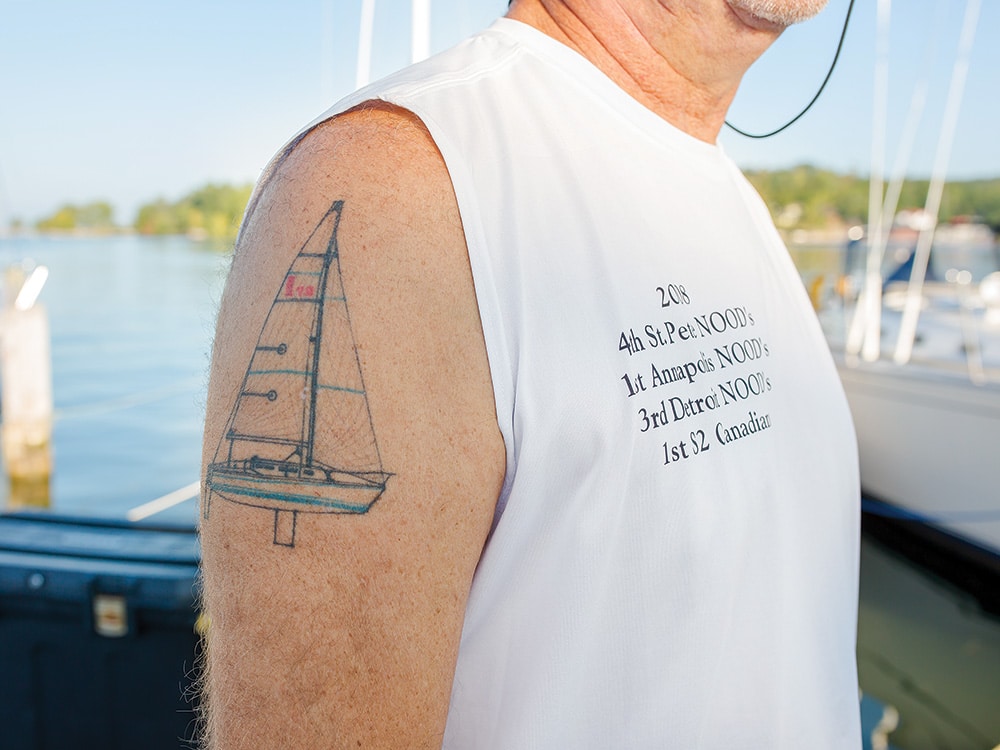
For the Holland championship, Kiss is sailing with his wife Tovi, son Mitchell, brother Stephen, nephew David and family friend Michael Norris. They finish fourth in the 28-boat fleet, winning the family trophy for the top boat sailing with three or more family members.
Meanwhile, aboard Second Wind , Don and Jean Bergman are sailing with their two sons. Don and Jean are veterans of the Sunfish class, with Don boasting of 30 Sunfish world-championship appearances to date. A few years after Don’s previous wife passed away, he married Jean, and began looking for a boat they could sail together. They’ve owned Second Wind for 28 years, which isn’t a rare accolade in this class, but their ages — Don is 86 and Jean is 78 — are noteworthy, especially after they win one of Saturday’s races. “It was so much fun,” says Don, “and the crew loved it. We got into the lead early and just protected it all the way around.”
Before heading into Saturday’s final races, Bergman was thinking it was the last regatta for his team, but after winning a race, he’s now motivated for more. “We’ll definitely do Detroit (site of the 2018 championship) next year,” he confesses, “and maybe a year or two after that.”
Coming from singlehanded-sailing backgrounds, the Bergmans both like to steer, which creates an unorthodox system on board Second Wind . “We started with him steering, but the problem is he wants to look around and see everything on the course,” says Jean. “I don’t have to do that. I can focus on just sailing.”
They agreed that Jean would drive upwind and Don would take the helm on the downwind legs. “It’s not the greatest idea, but it works for us,” says Jean, who sits behind Don as he gets the boat in position for the start.
“If I can get us in the right place,” he says, “I hand the tiller over to her with about five seconds to go, and she takes it from there.”
Like the Hilgers, the Bergmans travel extensively with their boat in tow, but with Holland, Michigan, as their home port, going to other regattas, such as Chicago, 85 miles away, or Racine, Wisconsin, 75 miles away, usually means sailing or motoring. For them, the boat is capable of handling just about anything.
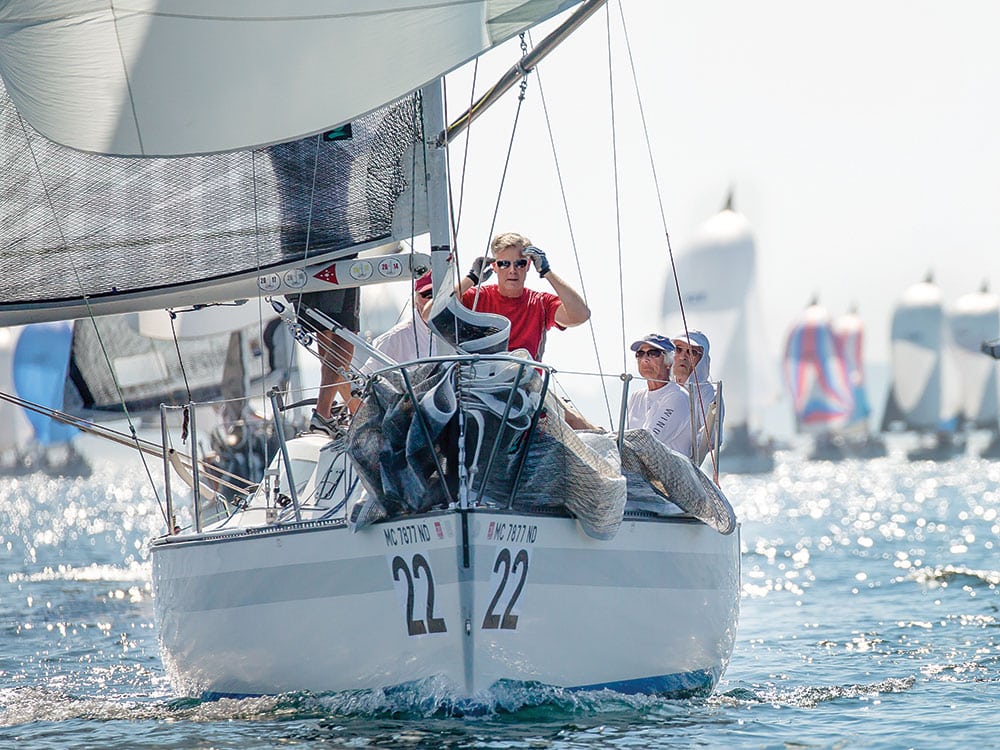
“One time, Jean and I were coming back at night, our motor quit, and our lights went out,” says Bergman. “The radio was telling everyone to get off Lake Michigan because a killer storm was coming, but we were right in the middle of the lake. So, we took the main down and sailed with our small jib. Jean was steering while I spilled the jib every time a 40-knotter hit. We couldn’t even see our compass. We just kept going.”
It’s a testament to Graham and Schlageter’s utilitarian design that the boats remain sought after three decades later.
Paul Letour, of Nashville, was 40 years old before he got his first sailboat. “I fell in love with the sport and went through a couple of boats,” he says. He didn’t understand one-design racing but grew into it and figured it out. “There were a couple of 7.9s where I live, so I joined up with them and never looked back.”
Letour then made the bold decision to attend a national championship. “We felt we were pretty good sailors, so we thought we’d see what we could do,” he says. “It was on Lake Erie, and out of 30 boats, we came in 30th. We went back with our tails between our legs, but I’m stubborn enough that I said, ‘Guys, we’ve got to do better.’ So, we kept going back and getting a little better each time. I wouldn’t go away.”
A retired dermatologist, one of Letour’s boats is named Itch and the other Scratch , but it’s more than just an homage to his former profession. “Itch is a synonym for a passion,” he says, “and a scratch boat is the boat you’ve got to beat, something you’ve just got to go after.”
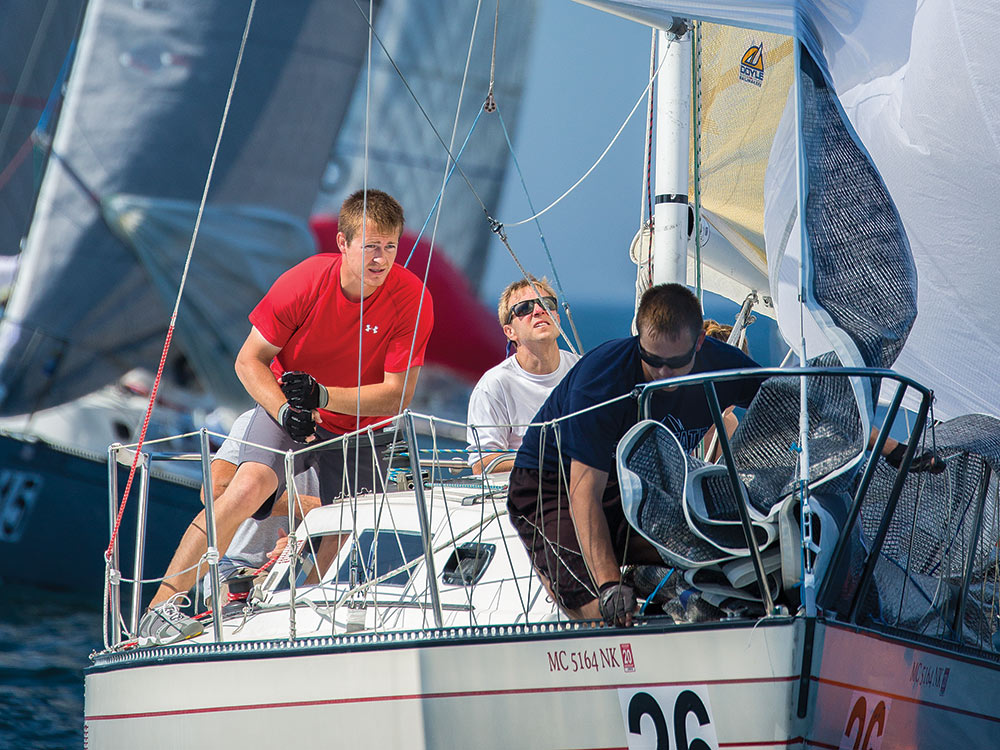
He especially likes the ability to easily transport the 7.9: “Put it on the trailer. Come to Nashville. Go to Racine. Go to Holland. It’s all so doable.”
Accessibility also ranks high on his list of the 7.9’s best attributes. “This is a boat that, with attention to detail, you can sail to its numbers in maybe two years,” he says. “I have friends in Nashville who sail other boats, and it will take them 15 years before they can race them like we do ours.”
At age 72, Letour maintains two 7.9s. He keeps one at each of the two yacht clubs in the Nashville area, which naturally makes him the local spark plug and salesman. Letour eventually convinced other owners to travel to Nashville for an annual event called the Equalizer, which is held on J. Percy Priest Lake. It’s become a regular part of the 7.9 circuit, in large part due to Letour’s Southern hospitality, which includes housing competitors and serving them his famous gumbo.
While there’s plenty of enthusiasm among 7.9 owners today, like any boat that’s no longer in production, the boat does present its challenges: It’s balsa-cored, which, according to Bosma, is rarely a problem in the hulls. “Once in a while you’ll find some wet spots in the deck,” he says.
Then there’s the issue of replacement parts. The class recently found a company to build a dozen masts to class specs. Next is sourcing a builder for replacement rudders, a topic the fleet tackles at the annual meeting one evening after racing.
“It’s just another issue, like the other ones,” says Letour, “and like those, we’ll get it figured out.”
Which is to say it’s like waiting for wind to complete a class championship on a warm Michigan day. Even if the breeze never materializes, they find a way to enjoy it. The company couldn’t be better.
- More: one-design , S2 7.9 , Sailboat Racing
- More Racing

INEOS Britannia’s Hot New AC75 Ready to Launch

Sailing’s Health Starts At Home

Luna Rossa’s New AC75 Marks Its Silver Age

Emirates Team New Zealand Splashes Defense Yacht

Wanderers of the Wayfarer Dinghy

Alinghi Red Bull Racing First to Reveal Its AC75

- Digital Edition
- Customer Service
- Privacy Policy
- Cruising World
- Sailing World
- Salt Water Sportsman
- Sport Fishing
- Wakeboarding

Also in Used Boat Notebook
- Hunter Passage 42
- Pearson Rhodes 41
- Santa Cruz 52
- Allied Princess 36
- Kelly-Peterson 46
Also from Brook Berth
- How do I replace my teak deck’s plugs?
- Sailing YouTube Channel
- July/August 2012
- View Winners
- 44 Wind in the Rigging
- 45 Moorings
- 45 Grand Prize
- 40 Womanship
S2 7.9 Detailed Review

If you are a boat enthusiast looking to get more information on specs, built, make, etc. of different boats, then here is a complete review of S2 7.9. Built by S2 Yachts (USA) and designed by Graham & Schlageter, the boat was first built in 1981. It has a hull type of Lifting Keel and LOA is 7.9. Its sail area/displacement ratio 19.87. Its auxiliary power tank, manufactured by undefined, runs on undefined.
S2 7.9 has retained its value as a result of superior building, a solid reputation, and a devoted owner base. Read on to find out more about S2 7.9 and decide if it is a fit for your boating needs.
Boat Information
Boat specifications, sail boat calculation, rig and sail specs, accomodations, contributions, who designed the s2 7.9.
S2 7.9 was designed by Graham & Schlageter.
Who builds S2 7.9?
S2 7.9 is built by S2 Yachts (USA).
When was S2 7.9 first built?
S2 7.9 was first built in 1981.
How long is S2 7.9?
S2 7.9 is 6.61 m in length.
What is mast height on S2 7.9?
S2 7.9 has a mast height of 8.97 m.
Member Boats at HarborMoor
- New Sailboats
- Sailboats 21-30ft
- Sailboats 31-35ft
- Sailboats 36-40ft
- Sailboats Over 40ft
- Sailboats Under 21feet
- used_sailboats
- Apps and Computer Programs
- Communications
- Fishfinders
- Handheld Electronics
- Plotters MFDS Rradar
- Wind, Speed & Depth Instruments
- Anchoring Mooring
- Running Rigging
- Sails Canvas
- Standing Rigging
- Diesel Engines
- Off Grid Energy
- Cleaning Waxing
- DIY Projects
- Repair, Tools & Materials
- Spare Parts
- Tools & Gadgets
- Cabin Comfort
- Ventilation
- Footwear Apparel
- Foul Weather Gear
- Mailport & PS Advisor
- Inside Practical Sailor Blog
- Activate My Web Access
- Reset Password
- Customer Service

- Free Newsletter

Pearson Rhodes 41/Rhodes Bounty II Used Sailboat Review

Hallberg-Rassy 42 Used Sailboat Review

How to Perform Your Own Pre-Buy Inspection

Beneteau 323 Used Boat Review

How Does the Gulf Stream Influence our Weather?

Can You Run a Marine Air-Conditioner on Battery Power?

Preparing Yourself for Solo Sailing

Your New Feature-Packed VHF Radio

Practical Sailor Classic: The Load on Your Rode

Anchor Rodes for Smaller Sailboats

Ground Tackle Inspection Tips

Shoe Goo II Excels for Quick Sail Repairs

What Oil Analysis Reveals About Your Engine

An Unusual Sailboat Shines a Light On A Sustainable Future

Is It Time to Get an Electric Dinghy Motor?

Bottom Paint 30-Month Update

Battle of the Teak Cleaners — Snappy Teak-Nu vs. Star Brite

New Seacocks for the Offshore Sailor

Bottom Paint Care

Are E-bikes Worth the Extra Weight and Cost?


How to Handle the Head

How to Select Crew for a Passage or Delivery

Preparing A Boat to Sail Solo

Re-sealing the Seams on Waterproof Fabrics

Waxing and Polishing Your Boat

Reducing Engine Room Noise

Tricks and Tips to Forming Do-it-yourself Rigging Terminals

Marine Toilet Maintenance Tips

Learning to Live with Plastic Boat Bits
- Sailboat Reviews
A roomy, well-built middle-of-the-road cruiser with both aft and center cockpit versions.
The history of S2 Yachts is in many ways a parable for the modern fiberglass sailboat industry. Begun in 1974 by an experienced fiberglass builder, the company grew rapidly, building first some unattractive “two-story” cruisers, followed by a series of conventional cruiser-racers in the late ’70s and early ’80s, then a successful fleet of race-oriented cruisers in the mid ’80s. Finally, as sailboat sales took a nosedive in the late ’80s, the company converted its entire production to powerboats.
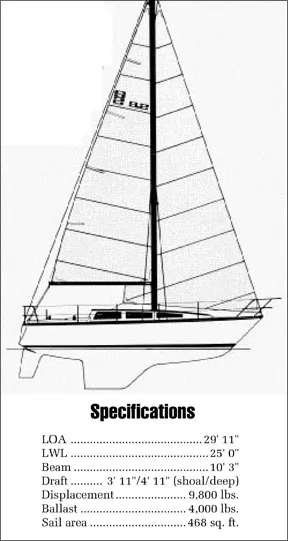
In late 1989, the company was approached by the class association of its popular 26′ racer, the S2 7.9. Would the company be willing to do a small run of 7.9s for those serious racers who wanted to replace their seven-to nine-year-old boats? The company thought it over and said, yes—provided they could be guaranteed 10 orders.
As we write this, the class association and S2 dealers around the country have been unable to come up with the 10 orders, and the company has cancelled the offering, perhaps the end of sailboat building by this prosperous company, and perhaps also an unfortunate commentary on the sailboat industry.
During its heyday, S2 developed a strong reputation for good quality boats. The company was founded by Leon Slikkers after he had sold his powerboat company, Slickcraft. As part of the sales agreement, he was not to make powerboats for a period of time, but there was no restraint on sailboat building. So he built a new plant which was, at the time, a model for production-line efficiency. Among other things, the hulls were laid up in an enclosed, climate-controlled room, and they remained in molds until most of the interior was installed to ensure that there was as little deformation of the basic molding as possible.
In the late 1970s, S2 did start building powerboats again, and soon established its Tiara line at the top end of the market. As evidence of Slikkers’ insight into the business (as well as a bit of luck, perhaps), when the conglomerate that owned Slickcraft began to see declining sales in the early ’80s, S2 was able to buy Slickcraft back at a fraction of its original sale price. And of course, S2 enjoyed the boom in powerboat buying which accompanied the decline in sailboat sales during the mid and late ’80s.
From the start, Slikkers also assembled an experienced crew of builders and sellers from the local area. At the time, Holland, Michigan, was the home of Chris Craft as well as Slickcraft and several other smaller powerboat builders.
The company continues today with a strong crew, managed primarily by Slikkers’ son, David, and other family members. The company personnel helped establish a reputation for good relationships with S2 owners, a reputation which continues, even though the company is no longer in the sailboat business.
In preparing this story, we talked with a number of S2 9.2 owners who reported that they are still able to get information, advice, and some parts and equipment from the company.
The Boat and Builder
As its nomenclature suggests, S2 Yachts was one of those few American companies willing to commit to the metric system when the government said it would be a good thing to do. The 9.2 stands for 9.2 meters, as with the company’s other boats (7.3, 7.9, 10.3, etc.). S2 stuck with the classification for a long time, only advertising the 9.2 as the S2 30 after it had been in production for years (not to be confused with the later S2 30 designed by Graham & Schlageter).
The boat overall is 29′ 11″, the most common length of 30-footers in those days when one of the popular racing rules—the Midget Ocean Racing Club (MORC)—required boats to be “under 30 feet.” The boat was built in two configurations, from 1977 to 1987. The 9.2C was a center-cockpit version, and the last one built was hull number 427. The 9.2A was the aft-cockpit version, and the last one built was hull number 520.
From talking to the company, it is unclear whether the hull numbers represent the actual number of boats built. In the 70s, it was not unusual for companies as part of their marketing strategy, to start a production run with hull number 10, or even hull number 100, so that a model would appear to be more popular or successful than it actually was. The people currently at S2 simply didn’t know if that had been done, but we suspect the total of 947 hull numbers is more than the actual number of S2 9.2s built. Nonetheless, the 9.2 had a successful run.
The 9.2 was designed by Arthur Edmunds, who was S2’s “in-house” designer. Beginning in 1981, S2 built a number of racing-oriented cruisers designed by the Chicago naval architects Scott Graham and Eric Schlageter, but all of the earlier cruising boats were done by Edmunds. Edmunds also contributed engineering and design detail to Graham & Schlageter’s hull designs.
We would describe the 9.2 design—and all of Edmunds’ S2s—as moderate and conventionally modern. The hull has short overhangs, a relatively flat sheer, a long fin keel, and spade rudder. The boats are reasonably attractive, and the aft-cockpit model has pleasing proportions. The center-cockpit model has a high, boxy superstructure whose profile is relieved by good contour moldings of the deckhouse, cockpit, and aft cabin.
One advantage of the conventional looks of the 9.2 is that it is not likely to go out of fashion—a plus for the boat holding its value. Though the rigs were identical on all versions, shallow-draft keels were a popular option; these reduced the draft from 4′ 11″ to 3′ 11″. The deeper keel doesn’t seem excessive for most waters and is our choice. The lead ballast is internal. S2 did a good job of embedding and sealing the lead in the keel cavity, so leaking should be minimal even in a hard grounding.
The hull is a conservative hand-laid laminate, and the deck is balsa-cored. S2 used a conventional inward-turning flange to attach the deck, with an aluminum toerail for protecting the joint. S2 is known for good glass work, particularly gelcoats, and almost all the used 9.2s that we have seen still are cosmetically good or recoverable with a good rubbing out.
Sailing Performance
‘Adequate’ would be a good way to describe the sailing performance of the 9.2. The boat came with a deck-stepped Kenyon spar and North sails as standard, later with Hall or Offshore spars. The rigging and other sailing hardware was good enough in quality that little re-rigging or upgrading is likely to be needed.
The used 9.2 we examined thoroughly, for example, had internal halyards, reef lines and outhaul, a good Harken mainsheet traveler, Lewmar #8 halyard winches, and two-speed Lewmar #30s for the jib sheets. On the down-side, every equipment list of used S2s we looked at listed the original North sails, with an occasional newer furling genoa. One disadvantage of a late model boat with good gear is that the owner is less likely to upgrade before he sells it, so the second owner probably will be facing the purchase of new sails.
When we sailed a shoal-draft 9.2, our initial reaction was surprise at its tenderness. Other owners in our survey agree that the shoal-draft model heels fairly easily, and a number thought that even the deeper draft model was tender. Several reported that you need to reduce sail fairly early to keep the boat on its feet and sailing well.
The boat sails reasonably well. The one we were on, however, would not go to weather decently—a combination of the shoal draft and a well-worn suit of sails. On other points, the boat was respectable. Close and broad reaching, it moved very well and was just a bit sluggish running.
She’s not a fast boat by contemporary standards. In most areas, the 9.2 carries a PHRF rating of 180 seconds per mile (six seconds slower for the shoalkeel), which is six seconds per mile slower than a Pearson 30 and 12 to 15 seconds slower than the popular Catalina 30 with a tall rig. In contrast, the 9.2’s racing-oriented sister, the S2 9.1, a 30-footer, rates 50 seconds per mile faster.
On the plus side, the boat is easy to sail, with a good balance between main and jib sail area. The running rigging and deck hardware is well set up. Oddly, not one equipment list for used 9.2s that we looked at had a spinnaker or spinnaker gear, an indication that the boat is rarely raced. However, if someone is interested in an occasional club race, the boat should sail up to its rating, assuming the sails are good and the boat well handled.
The deck is well laid out, though the walkways are a bit narrow for getting forward, and there’s a considerable step up into the center cockpit. Details of the deck—anchor well, bow fittings, cleats, halyard runs, and so forth—are well executed.
Performance Under Power
A few of the 1977/1978 boats were sold with an Atomic 4 gas engine. After 1979, diesels were installed. Through 1984, the engines were 12-hp or 15-hp Yanmars, or 12-hp Volvos. In 1985, a Yanmar 23 was optional.
The Atomic 4 was a good engine for the boat, as was the Yanmar 23. However, a number of owners report that the boat is underpowered with the Yanmar 12 and 15, and the Volvo 12. For a 10,000 pound boat, 12 to 15 hp would be adequate by traditional standards, but many sailors seem to want a little more these days. The Yanmar 15 in the boat we sailed had no trouble pushing the boat in calm waters, but the owner did say that the boat couldn’t buck any kind of head sea. For some, the optional Yanmar 23 will make the later models more desirable.
In the center-cockpit model, many owners complained about the inaccessibility of one side of the engine and the difficulty of getting at the dipstick, but otherwise the engine was serviceable. A few boats were apparently sold with raw-water cooling rather than a heat exchanger. We’d be cautious about one of the older boats with raw-water cooling unless it had been kept exclusively in fresh water.
The interior was undoubtedly the strong selling point of the boat. For the most part, the belowdecks finish is well done, and there’s about as much usable room below as you could get without making the hull significantly larger.
S2 was one of the first sailboat builders to use fabric as a hull liner, and it became almost a trademark of S2 interiors. The fabric is a neutral-colored polypropylene, treated to be mildew resistant. When we first saw the fabric, we were skeptical, wondering how it would hold up to saltwater soakings. But having owned a smaller S2 for five years, we finally became converts; in fact, in refitting our current boat, we used the fabric extensively, rather than replacing aged vinyl and wood veneer ceilings. The fabric is contact-cemented to the hull, and it holds up amazingly well, absorbing virtually no water. It is quite resistant to mildew and stains. The new owner of an S2 will want to find a good, compact wet/dry vacuum cleaner, which is the required maintenance equipment for the fabric.
The rest of the interior has teak veneer plywood, Formica, and solid teak trim, and the workmanship is good. Layouts changed little throughout the production of the boats. The aft-cockpit model is conventional, with a V-berth that is a bit short, a large head and hanging locker, a large dinette/settee with a settee opposite, and an L-shaped galley with a chart area/quarter berth opposite. There’s adequate stowage under the berths and decent outside stowage in the lazarettes.
The center-cockpit model moves the main cabin forward and the head aft, near to and partially underneath the center cockpit. The galley is opposite the head, running lengthwise down the port side of the cabin and partially under the cockpit. The aft-cabin is roomy, with an athwartship double berth and good locker space. The shortcoming of the center cockpit is that there is virtually no outside storage.
Choosing between the center and aft cockpit is largely a matter of personal preference. With children, or two couples cruising, the aft cabin is hard to beat for livability.
Overall, the interiors are well enough designed and executed that little major work or upgrading should be necessary on most used boats. Many people will want to replace the alcohol stoves on earlier models, perhaps add refrigeration (or replace the original Unifridge), and perform the normal long-term maintenance of re-upholstering, but otherwise the interiors should need little major attention.
Conclusions
The S2s were well-built. Whereas other production companies frequently cheapened or upgraded models from year to year to find marketing niches, S2 made boats to sell near the high end of the production boat market, and kept the quality at a consistent level.
The 9.2s have maintained their value about as well as any 30-footer in the current market. Because the only significant advantage of the 1986 model is the larger Yanmar engine and newer equipment, we would gladly take one of the older 9.2s at a lower price, since the necessary upgrades could easily be done (sails, cushions, electronics) and the final cost would still be much lower than the newer boat.
It’s easy to pay too much money for a used boat these days, but S2 owners generally think they have a good product, and they’ll probably be harder to dicker with than many sellers.
RELATED ARTICLES MORE FROM AUTHOR
Somehow this article is almost an exact copy of an earlier article here: http://www.sailingbreezes.com/sailing_breezes_current/articles/july99/s2review.htm by Thom Burns. Some sentences are exactly identical…
LEAVE A REPLY Cancel reply
Log in to leave a comment
Latest Videos
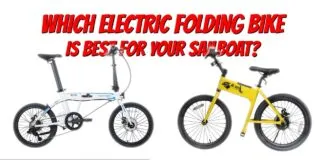
What Is The Best Folding Bike For Your Sailboat?

The No Expense Spared Antigua 60 Cruising Sailboat Soolaimon

How To Buy Sails – With Joe Cooper

Bavaria C42: What You Should Know | Boat Tour
- Privacy Policy
- Do Not Sell My Personal Information
- Online Account Activation
- Privacy Manager
Great choice! Your favorites are temporarily saved for this session. Sign in to save them permanently, access them on any device, and receive relevant alerts.
- Sailboat Guide
S2 7.9 FK is a 25 ′ 11 ″ / 7.9 m monohull sailboat designed by Graham & Schlageter and built by S2 Yachts between 1979 and 1987.
Rig and Sails
Auxilary power, accomodations, calculations.
The theoretical maximum speed that a displacement hull can move efficiently through the water is determined by it's waterline length and displacement. It may be unable to reach this speed if the boat is underpowered or heavily loaded, though it may exceed this speed given enough power. Read more.
Classic hull speed formula:
Hull Speed = 1.34 x √LWL
Max Speed/Length ratio = 8.26 ÷ Displacement/Length ratio .311 Hull Speed = Max Speed/Length ratio x √LWL
Sail Area / Displacement Ratio
A measure of the power of the sails relative to the weight of the boat. The higher the number, the higher the performance, but the harder the boat will be to handle. This ratio is a "non-dimensional" value that facilitates comparisons between boats of different types and sizes. Read more.
SA/D = SA ÷ (D ÷ 64) 2/3
- SA : Sail area in square feet, derived by adding the mainsail area to 100% of the foretriangle area (the lateral area above the deck between the mast and the forestay).
- D : Displacement in pounds.
Ballast / Displacement Ratio
A measure of the stability of a boat's hull that suggests how well a monohull will stand up to its sails. The ballast displacement ratio indicates how much of the weight of a boat is placed for maximum stability against capsizing and is an indicator of stiffness and resistance to capsize.
Ballast / Displacement * 100
Displacement / Length Ratio
A measure of the weight of the boat relative to it's length at the waterline. The higher a boat’s D/L ratio, the more easily it will carry a load and the more comfortable its motion will be. The lower a boat's ratio is, the less power it takes to drive the boat to its nominal hull speed or beyond. Read more.
D/L = (D ÷ 2240) ÷ (0.01 x LWL)³
- D: Displacement of the boat in pounds.
- LWL: Waterline length in feet
Comfort Ratio
This ratio assess how quickly and abruptly a boat’s hull reacts to waves in a significant seaway, these being the elements of a boat’s motion most likely to cause seasickness. Read more.
Comfort ratio = D ÷ (.65 x (.7 LWL + .3 LOA) x Beam 1.33 )
- D: Displacement of the boat in pounds
- LOA: Length overall in feet
- Beam: Width of boat at the widest point in feet
Capsize Screening Formula
This formula attempts to indicate whether a given boat might be too wide and light to readily right itself after being overturned in extreme conditions. Read more.
CSV = Beam ÷ ³√(D / 64)
A somewhat rare variant of the S2 7.9 with a fixed keel and masthead rig.
Embed this page on your own website by copying and pasting this code.
- About Sailboat Guide
©2024 Sea Time Tech, LLC
This site is protected by reCAPTCHA and the Google Privacy Policy and Terms of Service apply.

- Forum Listing
- Marketplace
- Advanced Search
- About The Boat
- Boat Builders Row
- Other Brands
- SailNet is a forum community dedicated to Sailing enthusiasts. Come join the discussion about sailing, modifications, classifieds, troubleshooting, repairs, reviews, maintenance, and more!
Bombay Express 26 VS S2 7.9
- Add to quote
We are looking at a few boats in the 26 to 28 range. We would appreciate any input on the Bombay Express 26 and S2 7.9. Thank you for all input.
It would be difficult to find two more different boats in the same length as those two. The S2 is a performance hull/racer/cruiser whereas the Bombay has shoal draft, full keel, barndoor rudder with almost catboat rig proportions despite the headsail/sloop configuration. The S2's lift keel with give you the same shallow draft access as the Bombay, and possibly both are trailerable. I suspect the S2 will sail circles around the Bombay but if in good shape the Bombay will probably get you more comments from passersby. I think you need to decide what kind of sailing you really want to do, what kind of boat truly appeals. To be zeroed in on these two indicates to me that you don't know yet...
I'll just second Faster's notion that you are still in the beginning stages of a search. Both might be nice choices, but very different boats. Unless you are in a geographical location with a very limited selection of sailing yachts for sale, consider more research and ask more questions here (or there).
I can only answer the S2 7.9 questions a bit... and I've only owned mine for a year but here goes. The Bombay Express 26 (which is obviously a more traditional layout full keel/centerboard boat). Bombay Express 26 BOMBAY EXPRESS 26 sailboat specifications and details on sailboatdata.com I'm going to stop there and say, other than both boats mentioned have the ability of shallow draft, and easy trailer launching, I think the similarities end there (I guess they both have tillers and have sails might also qualify, but that's stretching, you could also say they both float). The Bombay Express seems more pointed towards heavy cruising ruggedness, and less emphasis on fast. The S2 was a racing boat by design, especially for the MORC racing of the early 1980s. Lemme see if I can get give a brief summary of my S2 7.9, and there are several other owners on this site, I hope they chime in too.. The S2 is quick as a J/24, so it's really a racing boat (older, non-planing, symmetrical type of racing boat, but it's not really a cruiser for sure). The boat is easily trailered, in that it has a lifting weighted (600lbs) daggerboard (straight up lift, using 4:1 tackle and coach roof winch). The fractional rig is super simple, single upper, single lower, forestay and adjustable backstay. There are basically 2 different masts, old and new, so 2 different rig tuning guides... but basically the S2 mast is a telephone pole and doesn't really "bend" much. Mast is deck stepped (making trailering easy)... Most report that using the spinnaker pole to the spin ring, with a halyard through the end, you can winch up the mast... I use an A-frame (to me its safer for one person) boat draws about 18" of water keel up and rudder kicked up Boat draws 5' keel down The rudder is massive, 75lbs of glass, transom hung, and provides a pretty light steering arm due to its size. The boat is a BEAST to weather. With a well cut roachy main, and a 107% standard number 3, you'll outpoint most boats, with similar draft, and many with longer waterline. For a 26 foot boat, it has a rather large boom, at 12.5 feet. Care should be taken to properly size your traveler line, and blocks... most prefer a cascaded mainsheet, and 3:1 traveler.. boat came standard with 2:1 traveler, and 5:1 mainsheet. I'm weird in that we sail a mostly light air lake, I'm at 2:1 traveler, and 4:1 mainsheet. There are turning blocks for the boat standard behind the primaries, to provide a more unobstructed path for the genoa sheets, but most don't use them, some have removed them. The toe rail is alum, and spin sheets are run back to snatch blocks on the toe rail then back to the primaries. Boat does OK downhill, but prefers you to sail as deep a possible... it'll feel real slow, but for a DDW to bottom mark it may very well get there first over hotter boats with assyms. This usually surprises the Melges 24 owners. As it heats up, DDW can be real fun with centerboard up, no worries about turtling, the S2 has about 1000lbs of ballast in the hull bottom beyond the weight of the centerboard. The S2 7.9 comes in basically 2 models... Fixed keel Masthead model (rare they made like 50), and lifting keel fractional model (they made like 500)... within that they made inboard and outboard models. For racing many prefer the outboard model... the inboard model has less ballast, because of the weight of the motor. Many outboard models were actually inboard models converted to outboard, and some haven't compensated for the 200 or so pounds of ballast difference between them. Easy to see those boats, if you see an outboard model, floating about 2 inches higher than the waterline, it was probably an inboard converted to outboard. The boat is quick to speed, easily sailing 4 knots in 8 knots apparent with a full main and 155 number 1 (class states only a number 1 and number 3 carried, so 155, and 107%). It starts to heel quickly, with a fairly roundish bottom. But the ballast stiffens up the boat quickly once you hit say 20 degrees. The boat will take a beating and keep sailing, and can take large amounts of wind (we have pictures of a club mate sailing his S2 7.9 in 45 knots sustained with a double reef and a storm jib). You lose bite from the rudder between 35 and 40 degrees of heel, and you would be dragging and slowing pretty handily at that anyway... 20-25 degree of heel is ideal for making headway to weather, flatter can be faster too depending on sea state. The boat is heavy (my opinion) at 4500lbs disp. Sailboatdata shows the boats at roughly 4100, but actual class weighed boats are typically between 4400 and 4900. My own boat is roughly 4700 (yep that includes my 60lb outboard). The cockpit is tight, just enough room for about 2 people other than the skipper, 3 is OK, if they are cozy, 4 if they are SUPER cozy (class rules state 4 sailors min, 5 is typical for racing). Skipper gets their own space behind the traveler. The tiller arm is long and requires lifting for the skipper to switch sides on a tack. Many have shortened the tiller by 4-6 inches to make enough room to prevent that, and haven't reported my loss in control. it takes about 30 revolutions of the winch handle on the keel winch to bring the keel up, its the only self tailing winch on the boat, all are 2 speed winches. Below, I'll go over briefly... because it's a smaller boat it doesn't have much below. It has about 5'6" standing headroom (highest spot)... and is generally 5' for most of the usable cabin. Huge V-berth, probably 6.5' wide with full sitting headroom. 2 quarter berths that are at least 6.5' long. The boat has an enclosed head (centerboard trunk pretty much demands it)... does not have a door on the head, but a curtain. Some boats have full marine heads with storage, some have porta-potties, obviously the porta-potty option is the simpler option for most, and some were retrofitted to that for just that reason. Boat has a modest single battery config, some upgraded to 2 batteries, simple 9 switch panel, and just an ice box. The boat also has a manual pump 5 gallon water tank to the sink next to the ice box. Hope that describes the S2 a bit.
Tell us where you plan to sail, where you want to keep the boat, what kind of sailing you want to do (day sailing only, weekend overnight, short cruise), and you will get a lot more relevant answers and better advice on what boat might work well for you. There are a lot of very reasonably priced good boats out there, so you don't have to settle for a second best choice. I like BE 26. It is a well made boat that can be a lot of fun sailing and spending time in remote, quiet anchorages.
As trailer sailors (which is the only reason I can think of you might have latched on to these two boats)... many people fixate on the "trailerability" part. Even my light (by my S2 standards) Capri 22 was a huge hassle to trailer sail in a day. To be honest, I would NOT want to trailer something this big OFTEN. Which is why for me, this is a 2 times a year trailering experience... and that is it. 6000+lbs of boat and trailer are not my idea of a cup of tea to drag down the road, much less the fact that the boat is 9'4" wide, technically over the limit width wise (by a foot) without a permit. That being said, dragging it somewhere for a long weekend wouldn't be out of the realm. So don't think you are showing up at the waters edge with either of these, raising mast, sailing for 2-3 hours and going home after. While in a desperate pinch I've done it - trailer sailed a day sail - I arrived at the ramp at 8am, launched by 10am, and sailed until 5pm, and was home by 8pm. That's a long day, longer and way more complicated when you have trailer failures thrown in between to make things "interesting." Those things are par for the course, and one of those gotchas that all boaters know... the difference is ours is double complicated by adding trailer issues on top of boat/gear/rigging issues. Sometimes tow vehicle issues on top of that as well. Just some "food for thought." If your purpose is to try to day sail one of these large "trailerables." Oh and other well trailerable common boats in that size? Seaward 26rk, Oday 26, Catalina 25, Oday 25, Hunter 25.5, Beneteau First 26 swing keel if you can find one... and a plethora more especially slightly smaller at 22-23 feet.
Wow...I appreciate the input and candid replies. Thank you all. I suppose I should have begun the post with a bit of background. My wife and I are novices to sailing. We enjoy going out for daily cruises and some overnights. We own and sail a Pearson P30 which is docked on a deep water canal behind our house. The problem we have is the water gets real thin at the mouth of the canal and we can't get the boat out most of the time. We are tired of waiting on the HOA to dredge the canal and have put our P30 up for sale. We have had a few trade offers; this is where the post should have started. Thank to you all for any input and advice. d
That is good info and puts your query in a better perspective. I'd guess your P30 will be midway between your two candidates performance wise, and both, of course, will offer fewer amenities below for weekending and beyond. If you're after a good spritely daysailer with as good or better performance than what you're used to, then the S2 is probably the better choice. If owning and sailing what is something of a 'character boat' appeals despite what is likely going to be less stellar performance and maneuverability the I can see the appeal of the Bombay - always accepting that the condition of the two boats is otherwise similar...
I'd argue that the rudder on the S2 makes it a PITA to truly go shallow. I've seen great systems for pulling up the kick-up rudder, but not real great ones for pushing it back down. SHNOOL who for the helluva it this summer anchored in 2 feet of water, just to prove I could!
I wonder if anyone's ever made a cassette rudder for an S2? Probably makes more sense than a kick-up style.
Faster, you'd have at least 200 or so people interested if you could find one. My machinist buddy with his own business, is also an S2 owner, wonder if he can fabricate something.
We looked at an Albin Vega last week. The boat was solid but in need of lots of TLC. Priced right. Any input on the Albin Vega is appreciated.
I would avoid all boats that need a lot of TLC. It is a buyer market and lots of good boats out there which are ready to sail. Vega is a great little boat but if a boat is neglected it will have all kinds of expensive problems to resolve.
The Albin is a pretty popular boat... built like a tank. That's as much as I know about them. More room below than the others.
Have to agree with the above. While the Albin is a great, solid well regarded boat. starting out with something 'needing lots of TLC' seems unnecessary in today's used boat market.
- ?
- 174.6K members
Top Contributors this Month
- BOAT OF THE YEAR
- Newsletters
- Sailboat Reviews
- Boating Safety
- Sailing Totem
- Charter Resources
- Destinations
- Galley Recipes
- Living Aboard
- Sails and Rigging
- Maintenance

- By Richard Smith
- Updated: October 22, 2012

Within a wide field of well-designed and competitive racer/cruisers of the 1970s, the S2 9.2 stands out, mainly because it wears its age very well. Without a scoop transom and boarding steps or skinny portlights below the sheer, it still looks modern. The flat sheer, sloping deckhouse, almost-flush Lexan forward hatch, hinged anchor lid, and tinted deadlights are familiar features on boats built three decades later. The carefully detailed teak handrails set on molded fiberglass spacers are unobtrusive while emphasizing the hull’s refined shape and unified design. Nothing is exaggerated in the interest of the fashions of the day or to suit a rating rule.
Powerboat builder Leon R. Slikkers founded S2 Yachts in 1974 and commissioned Arthur Edmonds, designer of the Allied Princess 36 and Mistress 39, to design the S2 9.2A (for its aft cockpit) and the S2 9.2C (for its center cockpit). Over 700 A and C models were sold. Both versions have the same hull, fin keel, partially balanced skeg-hung rudder, and masthead sloop rig. The single-spreader aluminum mast, painted black (an S2 trademark) is stepped on deck over a compression post that’s built into the main bulkhead.
The hull is solid, hand-laid fiberglass. It has an inward-turning flange at the sheer to which the balsa-cored deck is bolted through an extruded aluminum toerail. There’s no molded interior liner. Bulkheads and furniture are tabbed to the hull, which contributes to its structural stiffness. Two tons of lead ballast is encapsulated in a sealed keel cavity. Well-cared-for boats show little wear and tear after three decades of hard sailing, and, owners agree, the gelcoat is generally free of stress cracks even where moldings take tight bends.
The T-shaped cockpit is comfortable and workmanlike. The starboard seat opens to general storage and access to the stuffing box and engine controls. Additional storage is located under the helmsman’s seat in twin lazarettes.
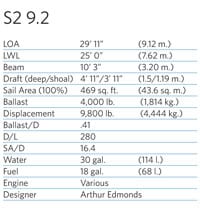
Everything on deck is carefully laid out. The mainsail is sheeted abaft the 28-inch wheel, where it’s out of the way but in reach of the helmsman. The 8-inch stern cleats are mounted on anti-chafing pads and close to hand. Engine controls are similarly convenient to the helm. Early boats had Atomic 4s, but a variety of diesel engines were fitted after 1978.
The engine box provides a wide first step down to the cabin. A small corner galley to starboard of the companionway contains a sink, icebox, and stove. Opposite is a quarter berth and navigation space with a folding seat and table. Headroom is 6 feet 3 inches aft and drops gradually to about 5 feet 10 inches toward the forward cabin.
The saloon table and settee convert to a double berth and, together with a 6-foot-6-inch settee opposite, make a comfortable eating, lounging, and sleeping area. A double berth is located forward of the wardrobe and head area. Generous use of teak, both solid and ply, contributes to a sense of quality throughout the boat, but the polypropylene carpeting used to line the hull ages unattractively.
Sailing the S2 9.2 is a treat. In 15 to 17 knots, it heels sharply under the mainsail and 150-percent genoa before settling in to make 5 or 6 knots upwind. Weather helm is noticeable in stronger gusts, but the boat is generally well balanced and always manageable, even in lumpy seas. All in all, the S2 9.2 is a well-designed, tough, and able 30-footer with good performance for racing or cruising.
Architect Richard Smith and his wife, Beth, sail their Ericson Cruising 31, Kuma, in the Pacific Northwest.
Find more Cruising World boat reviews here . Read the review of the S2 8.6 here .
- More: 21 - 30 ft , before 2000 , Coastal Cruising , monohull , Sailboat Reviews , Sailboats , sailboats classic plastic
- More Sailboats
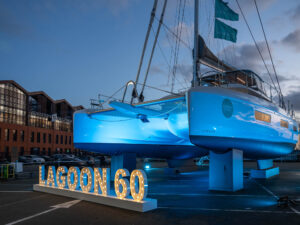
Lagoon 60 Prepares for World Premiere
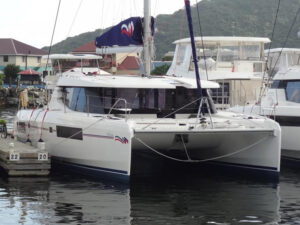
Now For Sale: Leopard 45
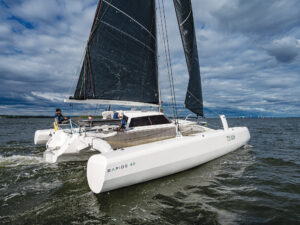
Sailboat Review: Rapido 40
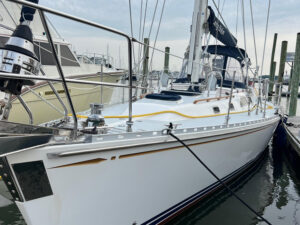
For Sale: 2002 Hylas 46
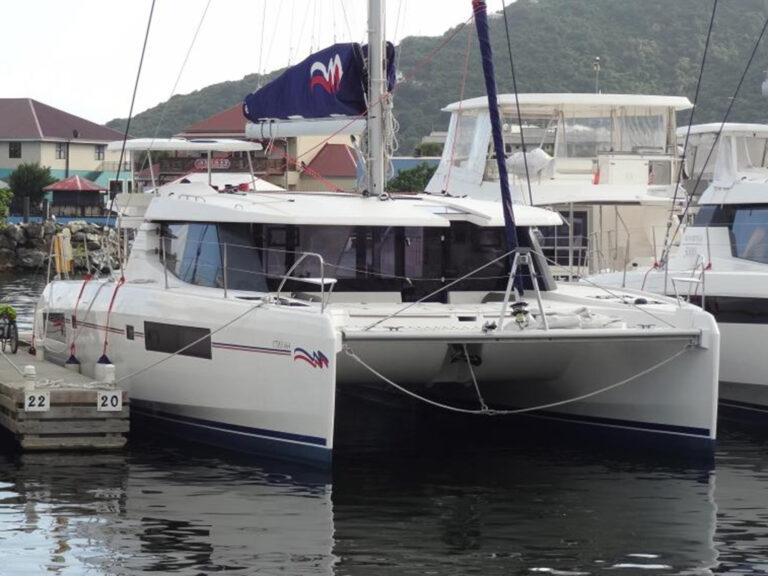
The Long Way Around

Sailing to the Land of Shrimp
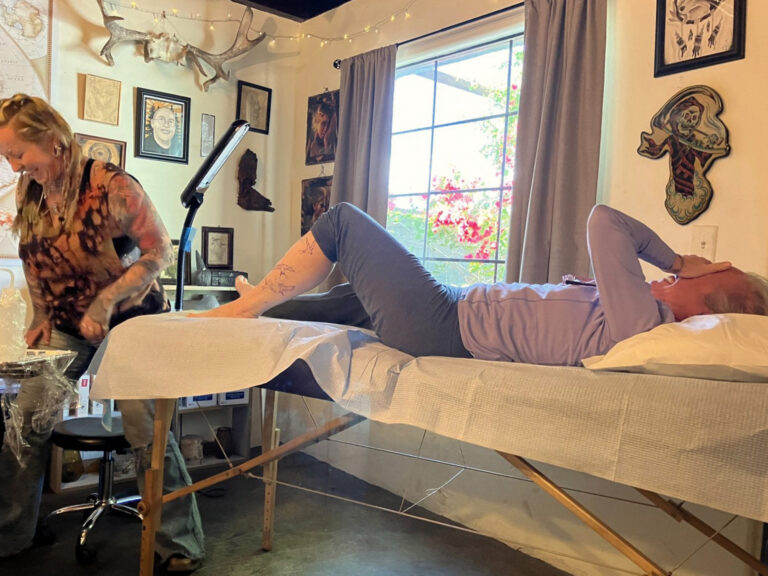
Swallow Tattoos and Sailors
- Digital Edition
- Customer Service
- Privacy Policy
- Email Newsletters
- Cruising World
- Sailing World
- Salt Water Sportsman
- Sport Fishing
- Wakeboarding

- Forums New posts Unanswered threads Register Top Posts Email
- What's new New posts New Posts (legacy) Latest activity New media
- Media New media New comments
- Boat Info Downloads Weekly Quiz Topic FAQ 10000boatnames.com
- Classifieds Sell Your Boat Used Gear for Sale
- Parts General Marine Parts Hunter Beneteau Catalina MacGregor Oday
- Help Terms of Use Monday Mail Subscribe Monday Mail Unsubscribe
S2 7.9 F-150 or F-250?
- Thread starter Git-R-Done
- Start date Dec 1, 2008
- Forums for All Owners
- Trailer Sailors
I'm about to purchase an S2 7.9, and I'm thinking about a towing vehicle for it. I currently own a Catalina 25, and the consensus of C-25 owners is that you need a really big truck--an F-250 or equivalent. However, the 7.9 is about 1,000 pounds lighter than the Catalina 25. I'm wondering if a F-150 is enough truck for the job. It would be great if the smaller truck would work since it's cheaper, gets better gas mileage, and is more useful overall. The boat weighs about 4600 pounds (right?) and the trailer must weigh 750 ? (wild guess). Cheers, Bruce Baker Falls Church, VA
Bruce, The short answer is that either option should work fine, it comes down to your personal preference. My previous boat was a J-24 which is similar in size and weight to the S2 7.9. I towed 25K+ miles in the 5 years I had the boat with a Chevy 1500. I did opt for the larger option engine and tow package including transmission cooler. The boat sat on a tandem axle, with 4 wheel surge brakes trailer. I towed all over the Carolina's, Georgia, and Florida without an issue. I did use a friends Chevy 2500 HD diesel with the Allison transmission for one trip. No doubt the 2500 had more power to accelerate and stiffer suspension so the ride with the boat was smoother than with my 1500. For day to day driving without the boat the 1500 was a much smoother ride than the 2500 even though I have the 4x4 off road package. Good Luck, --Eric
I don't know where you got the idea that the S2 7.9 is 1,000 lbs. lighter than the Catalina 25. IIRC, the Catalina 25 is 4160 lbs. and the S2 7.9 is 4250 lbs. Either should be relatively manageable with an F-250, and both should be doable, but not as comfortably, with a properly equipped F-150. It really depends on which F150 you have and how it is equipped. What gear ratio does it have? What engine does it have? I trailer my boat with an Explorer with no problems, and the boat and trailer are probably as heavy as the boat and trailer you're looking at or fairly close. But I wouldn't dare try it with my friend's Explorer. Mine is a V8-equipped with the factory-installed tow package, his is a V6 without the tow package. Look in your owner's manual, as it should say what the maximum towing capacity for your truck is. If the weight of the boat and trailer are close to the maximum for your truck, it might be worth trying before making a decision one way or the other. If the weight of the boat and trailer are above what your truck is designed to handle... your decision is made for you. The 2009 F150 has a towing capacity range from 5400 lbs. for the 2WD to 11300 lbs. for the high-end 4WD version of the truck.
This is a very good question. I spend many days trying to figure this out. Her is the story. I tried towing my 1984 Hunter 25.5 with Chevy G20 I believe this is a 1500 with a 5.0 engine. The manufacturere is not clear what its towing capacity is. The boat with the trailer is about 6200 lb. I believe that the truck was putting out 110% of its capability. So I bough a GMC V8, 2500. The engine is smaller, 4.8 , the gear ratio is higher and it has a towing package. I installed a towbar with 10000lb towing capablity. The trailer has surge brakes. If you are going to buy a truck to tow your sailboat - go with 2500 with 8 lug bolts on the wheels instead of 6 lug bolts. The gas milage is not that much different. You will be glad that you have the added power when need it. Buy the way my 1500 Chevy developed transmission problems at a cost of $ 3000.00 soon after the tow. Good luck - see you on the water.
George H260
Most people don't know what their boat weighs - I would not rely completely on antodotial comments and you can't rely much on manufacturers published data. My suggestion is to require the seller to provide a certified weigh ticket as part of the deal. This usually costs $10 at a public scale. Then the solution is simple: Step 1: Weigh the boat Step 2: Buy a truck that is certified to tow that weight. All vehicle manufacturers are required to provide load and towing certifications for the folllowing: Gross Combination Weight (GCW) - Total weight of a fully equipped truck and trailer with cargo, driver, and passengers, fuel, coolant, equipment, etc. Gross Combination Weight Rating (GCWR) - Maximum allowable gross combination weight (GCW) Gross Trailer Weight (GTW) - The weight of the trailer plus all the cargo in it. This is measured by putting a fully loaded trailer on a scale. Gross Trailer Weight Rating (GTWR) - Maximum allowable weight of the trailer, plus its cargo. Gross Vehicle Weight (GVW) - The total weight of the tow vehicle, including driver, passengers, and any special equipment (options, accessories and upfitted equipment), cargo, fuel, collant, etc. Gross Vehicle Weight Rating (GVWR) - The maximum allowable total wieght of the tow vehicle, including driver, passengers, any special equipment (options, accessories and upfitted equipment), cargo, fuel, collant, etc. If you want to explore this subject more go to this link. There is lots of info that should help. http://h260.com/travel/travel.html
To find the true tow capacity of any vehicle, obtain the GCWR and subtract the weight of the tow vehicle when ready to tow. The answer is the max weight you can tow.
sand sailor
santana 27' #5000 +- no brakes yet , chevy 1/2 ton works hard every other day so why not on sunday too
I looked at towing capacity ratings online and determined that certain F-150's have the grunt to do the job. I ended up buying an '07 F-150 with the 5.4 litre motor, short bed, extended cab, factory installed towing package. Supposedly, this rig can tow 7,700 pounds. Most of the time, I couldn't even tell that there was a boat back there. However, on the hills of Tennessee and SW Virginia, we slowed to 50mph. On the flats, I tried to keep her to 60, but ended up at 65 a lot of the time. We averaged 18mpg on the way down and 12mpg on the way home. Cheers, Bruce
- This site uses cookies to help personalise content, tailor your experience and to keep you logged in if you register. By continuing to use this site, you are consenting to our use of cookies. Accept Learn more…
- Print This Page
- Text Size
- Scroll To Top

- New Member Signup
- Classified Ads
- About the S2 7.9
- Class Rules
- Sail Certificates
- Event Calendar
FAQ / Tech Library

IMAGES
VIDEO
COMMENTS
A fast and competitive 26-footer with a daggerboard and a trailerable design. Read the review of the S2 7.9's construction, performance, and features, as well as the pros and cons of this boat.
A detailed review of the S2 7.9, a high-performance sloop designed for racing and cruising. Learn about its construction, accommodations, rigging, performance, and history.
S2 7.9 - Practical Sailor. Since 1974, Practical Sailor's independent testing has taken the guesswork out of boat and gear buying. www.practical-sailor.com. The association reports 400 were built. Designed to be a one class racing boat.
Today they build 30- to 53-foot luxury motor yachts, but from 1980 and 1994, the building was occupied by S2 Yachts, which put out an eclectic line of sailboats that included the 7.9.
AKA the Grand Slam 7.9 Sail area: -Main: 180 ft² / 16.72 m² -Jib: 149 ft² / 13.84 m² A few (17) were delivered with a fixed keel and masthead rig. (See S2 7.9FK for specs.) Inboard power available as an option… BMW 7.5 hp diesel.
S2 7.9 is a 25′ 11″ / 7.9 m monohull sailboat designed by Graham & Schlageter and built by S2 Yachts starting in 1981. ... Sail area in square feet, derived by adding the mainsail area to 100% of the foretriangle area (the lateral area above the deck between the mast and the forestay). D: ...
The S2 7.9 rates like a J/24 in speed, has 5'8" headroom for the highest point in the cabin, has a decent sized V birth, a foot pump sink, porta-pottie to starboard enclosed with a curtain, and came in 4 basic versions.. of 550ish hulls. 1) A fractional rig with a lifting keel with outboard.
The S2 7.9, originally called the Grand Slam 7.9, is an American sailboat that was designed by Graham & Schlageter as a one-design and Midget Ocean Racing Club (MORC) racer-cruiser and first built in 1979.
The boats have a large, long cockpit with an outboard rudder and tiller. The 7.9 name refers to the LOA of 7.9 meters, translating to 25 feet, 11 inches. The waterline length is 21 feet, 8 inches, with a maximum beam of 9 feet. The boat draws 5 feet with the keel down, but will float in a skinny 13 inches with everything up.
For the Great Lakes region of the United States and Canada, the utilitarian S2 7.9 fleet has been a stalwart for many years and is as popular as ever. Built by S2 Yachts, in Holland Michigan, the S2 7.9 meter yacht was designed by Scott Graham & Eric Schlageter and was originally put into production in 1981. The original production run lasted ...
If you are a boat enthusiast looking to get more information on specs, built, make, etc. of different boats, then here is a complete review of S2 7.9. Built by S2 Yachts (USA) and designed by Graham & Schlageter, the boat was first built in 1981. It has a hull type of Lifting Keel and LOA is 7.9. Its sail area/displacement ratio 19.87.
In contrast, the 9.2's racing-oriented sister, the S2 9.1, a 30-footer, rates 50 seconds per mile faster. On the plus side, the boat is easy to sail, with a good balance between main and jib sail area. The running rigging and deck hardware is well set up.
A somewhat rare variant of the S2 7.9 with a fixed keel and masthead rig. Suggest Improvements. Source: sailboatdata.com / CC BY. Embed. S2 7.9 FK is a 25′ 11″ / 7.9 m monohull sailboat designed by Graham & Schlageter and built by S2 Yachts between 1979 and 1987.
Registration is now open for the 2024 CCRSeptember 19-22MBYC Holland, MIThis year the Class Championship moves back to the home of the S2 7.9 in Holland, MI. Join us on the shores of beautiful Lake Michigan and Macatawa Bay for the 2024 Class Championship. Macatawa Bay Yacht Club has a ramp on site and trailer parking nearby.
We currently own a 17.5 foot "micro cruiser" keelboat (its a Renkin 18) which displaces 1220 pounds, has 450 lbs of ballast, a draft of 2 feet, and a sail area of 150 ft^2. The S2 7.9 displaces ~4500 lbs with 1750 lbs of ballast, 5 feet of draft (lift keel down), and has sail area of 329 ft^2.
S2 7.9 Tuning Guide Welcome to the Doyle Boston S2 7.9 tuning guide. As the name suggest this is only a guide and it has been developed over the last twenty-four years to help our customers relate information back and fourth and to allow us to compare apples to apples when we talk before, during and after regatta's.
The S2 is a performance hull/racer/cruiser whereas the Bombay has shoal draft, full keel, barndoor rudder with almost catboat rig proportions despite the headsail/sloop configuration. The S2's lift keel with give you the same shallow draft access as the Bombay, and possibly both are trailerable. I suspect the S2 will sail circles around the ...
Sailing the S2 9.2 is a treat. In 15 to 17 knots, it heels sharply under the mainsail and 150-percent genoa before settling in to make 5 or 6 knots upwind. Weather helm is noticeable in stronger gusts, but the boat is generally well balanced and always manageable, even in lumpy seas. All in all, the S2 9.2 is a well-designed, tough, and able 30 ...
3,502. - Telstar 28 Buzzards Bay. Dec 1, 2008. #3. I don't know where you got the idea that the S2 7.9 is 1,000 lbs. lighter than the Catalina 25. IIRC, the Catalina 25 is 4160 lbs. and the S2 7.9 is 4250 lbs. Either should be relatively manageable with an F-250, and both should be doable, but not as comfortably, with a properly equipped F-150.
The S2 7.9 sailboat is commonly used for both racing and cruising. It offers a good balance between performance and comfort, making it suitable for various sailing activities. Is the S2 7.9 trailerable? Yes, the S2 7.9 is trailerable. It can be transported on a trailer, allowing owners to easily launch and retrieve the boat from different ...
A place for S2 7.9 owners to discuss anything and everything S2 7.9. Tips & tricks for racing, upgrades, general maintenance, or anything else pertaining to the S2 7.9. Only members can see who's in the group and what they post. Anyone can find this group. Group created on November 8, 2022.
It takes into consideration "reported" sail area, displacement and length at waterline. The higher the number the faster speed prediction for the boat. A cat with a number 0.6 is likely to sail 6kts in 10kts wind, a cat with a number of 0.7 is likely to sail at 7kts in 10kts wind. KSP = (Lwl*SA÷D)^0.5*0.5
Boat: (Cruiser Living On Dirt) Posts: 49,636. Images: 241. "S2" marketed the 27 footer (26'-7" LOA) as a "Performance Cruiser", of which they built 85 examples from 1985 to 1987, when Sailboat production was ended. All S2 cruising sailboats, including the 27', featured a solid fiberglass hull, and a balsa cored deck.